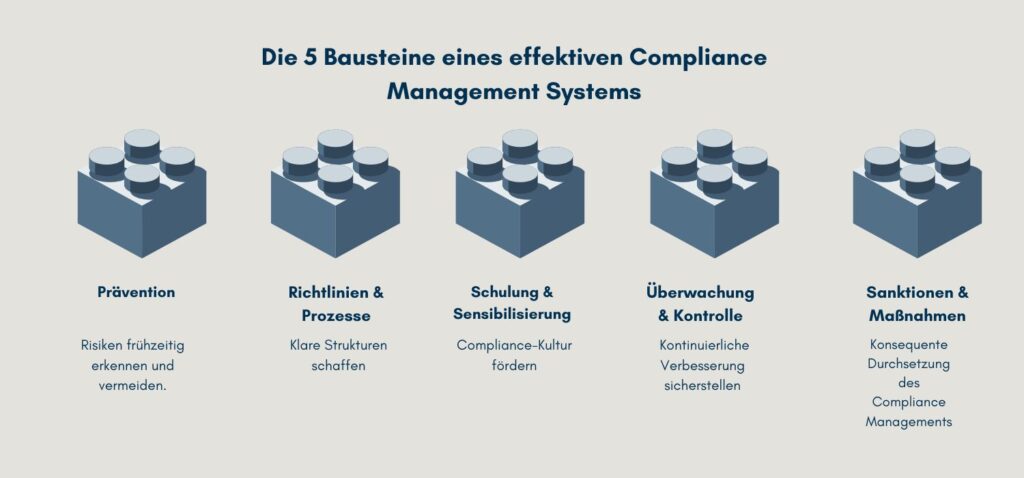The 5 building blocks of an effective Compliance Management System
An effective compliance management system protects companies from legal risks, strengthens corporate integrity and ensures long-term success. In this article, we present the five central pillars that form the basis and give you concrete examples from our consulting practice.
Why strong Compliance Management is essential
In today’s corporate world, effective compliance management is crucial for adhering to legal regulations, minimising risks and strengthening the trust of customers and partners. Companies that neglect Compliance risk not only heavy penalties, but also significant reputational damage. Another selling point, if you like, is that a well-functioning compliance management system (CMS) is increasingly seen by investors and business partners as a sign of quality. A well-structured CMS is based on five central pillars that are essential for successful implementation.
But what exactly is a CMS? It is not just a computer programme, but rather a systematic set of guidelines, processes and measures that ensure that a company complies with all relevant legal and ethical requirements. In many cases, it is supplemented by supporting software solutions, but at its core it is about organisational structures and responsibilities.
A well-structured CMS is based on five central building blocks that are essential for successful implementation.

1. Prevention: recognising and avoiding risks at an early stage
As always, the best way to avoid (compliance) problems is proactive prevention. Companies are well advised to recognise potential risks at an early stage and take appropriate measures to prevent breaches of the rules from occurring in the first place. This includes a regular risk analysis in which internal weaknesses, regulatory developments and industry-specific trends are systematically assessed. Targeted guidelines can be developed on this basis, for example in the form of a clearly formulated code of conduct or specific company guidelines. Internal controls and regular audits also ensure that processes function reliably and deviations are recognised at an early stage. In addition, anonymous whistleblower systems promote a culture of openness and help to uncover irregularities at an early stage.
2. Guidelines & Processes: Create clear structures
Functioning compliance management depends on clear formulations of corporate values and ethical behaviour. Companies therefore need binding guidelines and standardised processes that create transparency and support the legally compliant actions of everyone involved. This includes basic compliance principles as well as detailed regulations on specific topics – such as data protection, anti-corruption, labour law or IT security. These guidelines should be dovetailed as closely as possible with operational processes, for example through digital workflows or automated checking mechanisms. At the same time, integrated compliance processes regularly review these guidelines in order to adapt them to new legal requirements or technological developments if necessary. This is particularly important in an environment characterised by digital transformation and growing regulatory complexity.
Companies, or more precisely the Compliance Office, should also ensure that the relevant guidelines are regularly reviewed and adapted to new legal framework conditions. Particularly in times of digital transformation, technological developments not only regularly give rise to new regulations, but existing regulations are also constantly being adapted.
3. Training & Awareness Raising: Promoting a Compliance Culture
Employees are the key to successful compliance management, because compliance begins in the mind. Even the best system is ineffective without the awareness and active involvement of employees. This is why regular training and targeted sensitisation measures are a central component of an effective CMS. Depending on the size of the company and industry, these can take the form of practical training programmes, interactive e-learning courses or workshops with realistic case studies. Digital learning platforms also enable employees to familiarise themselves with relevant compliance topics such as data protection, corruption prevention or competition law at any time and from any location. It is particularly important that managers set a good example and fulfil their special role in implementing the compliance strategy. If employees not only know what is permitted, but also understand why certain rules exist, a genuine compliance culture can be established within the company.
If compliance is integrated into the corporate culture, the probability increases that rules will not only be adhered to, but actively practised.

4. Monitoring & Controlling: Ensuring continuous improvement
A compliance management system is not a static concept. Compliance with the relevant laws and regulations must be continuously monitored and optimised. This is achieved through structured monitoring and effective control mechanisms. This can only be achieved through systematic monitoring, in which internal and external audits play an important role. They are supplemented by transparent reporting and digital technologies that can provide indications of breaches of regulations, for example with automated checking mechanisms or AI-supported analyses. Confidential reporting channels and whistleblower systems also contribute to monitoring. Consistent monitoring can ensure that the compliance system not only exists on paper, but is actively practised.
It is also important to note that if, despite all preventive measures, breaches do occur, companies are obliged to ensure that they are consistently investigated. Below we explain the steps that need to be taken following a breach.
5. Sanctions & Measures: Consistent enforcement of compliance management
A compliance management system is only effective if violations are taken seriously and penalised appropriately. Every reported or recognised violation must be systematically investigated. This includes a thorough analysis of the causes. Companies must define clear disciplinary measures and response mechanisms. A catalogue of measures, so to speak, which also includes further legal steps. This should be communicated clearly and transparently to all employees and enforced uniformly and fairly. rom warnings to legal consequences, measures should be adapted to the severity of the offence.
However, dealing with violations does not begin with punishment – but with careful investigation of the causes. Transparent escalation processes help to clearly define responsibilities. And just as important: after an incident, processes and guidelines should be reviewed and adapted if necessary. After all, any misconduct also offers the opportunity to further develop the system and avoid future violations. Consistent sanctions strengthen trust in the system and show that compliance in the company is not just a theory, but is actively implemented.
Conclusion: Strong Compliance Management protects your company
As we have shown, a well thought-out compliance management system is based on the five pillars of prevention, guidelines, training, monitoring and enforcement. For those who want to delve deeper, we recommend our article on compliance controlling. Here we present important key figures and KPIs for effective monitoring.
If you are now worried that you have a lot of work ahead of you, let us prove that compliance can act as a bureaucracy killer. You can find out more about the strategic importance of the Compliance Office in our supplementary blog article.
We will also introduce you to the different types of risk reporting, how and, above all, when to use them.
As an experienced partner, the BAMAC Group is ready to accompany companies on this path – with customised solutions that not only offer legal security, but also create sustainable added value. The success of our clients spurs us on to continue developing innovative and flexible approaches in IT and compliance consulting.
Get on your way!
The BAMAC Group is happy to support you because we know how to successfully organise compliance and risk management projects and implement sustainable changes. Get in touch with us now for a non-binding initial consultation.

Categories of this post
Further interesting posts.









